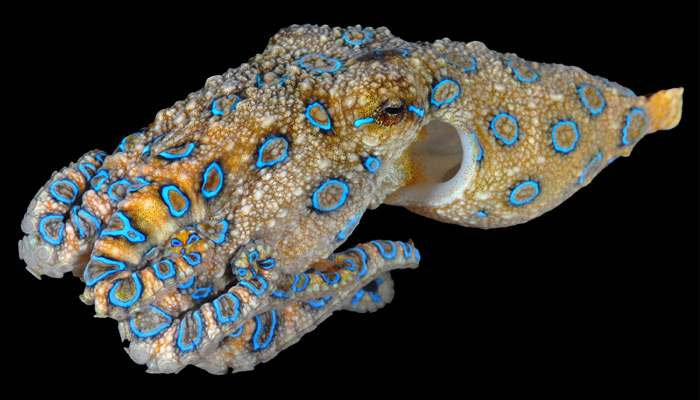Every now & then the husband goes on a fossil-fossicking expedition, in order to add to his collection of things long dead & turned to stone. There are a number of good sites in the Waikato region, and one of them has yielded quite a few belemnite remains: specifically, the bullet-shaped fossilised internal shells of one group of cephalopods. Plus he's also found a few rather lovely ammonites, though nothing on the same scale as a giant specimen found near Kawhia Harbour in 1977. (Apparently the largest of all was found in Germany – its shell, if uncoiled, would be close to 11m long!).
The evolutionary history of cephalopods spans around 500 million years, and there's a good overview of this on the UCMP(Berkeley) evolution website. I hadn't visited this part of their site before, but was directed there by PZ Myers (who else?) & his use of this stunning image – too beautiful not to share 🙂

Beautiful, but deadly:
These little molluscs – members of the largest species grow to be about 15 cm long, head tip to tentacle tip – produce two different venoms. One, they use in hunting their usual prey1 of crabs and shrimps; the other is released when the animals are alarmed or agitated. While people certainly report blue-ringed octopus bites, it seems that the toxin may also be secreted directly into the water: the author of this website reports feeling localised neurological symptoms after putting his hand into a tank of seawater that had been used to transport a largish specimen. The venom contains the poison tetrodotoxin (TTH)2, also produced by a range of other organisms including a genus of newts, some harlequin frogs, snails, and worms from a number of different phyla. And, of course, the pufferfish, whose family name (Tetraodontidae) gives us the name of the toxin.
This poses an interesting question: why would members of so many different phyla evolve the same poison? It turns out that it's not actually the animals who make the TTH: the job's done by colonies of symbiotic bacteria living in their poison glands. Life really is more complex and more complicated than we can imagine.
1 Sometimes, the prey fights back:
2 It's been suggested that TTH is the mysterious ingredient supposedly used in zombifying people – you'll find an interesting discussion of this idea here on HowStuffWorks.
herr doktor bimler says:
But that colour scheme! Clearly it is all done with Hollywood CGI.